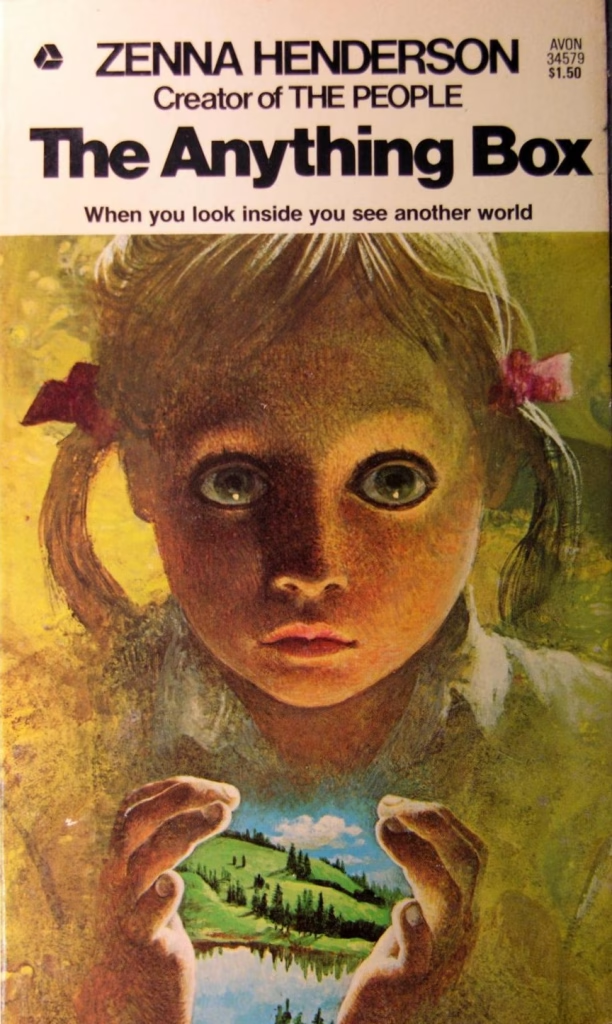(Please note: This post was originally guest-posted on Shannon Lawrence’s The Warrior Muse blog for Women in Horror Month. I’m reposting it here so I don’t LOSE IT!!!)
The sci-fi writer Zenna Henderson died in 1983, which was years before I was given the short story collection The Anything Box by my cousins, and devoured it with such a passion that the front cover fell off. I eventually read the stories she was more famous for, her People stories, but I never really gelled with them the way I did with the stories in The Anything Box.
Here’s the general idea behind most of the stories:
Once upon a time, there was a teacher. (Or a housewife, although in one particularly memorable case it’s a husband.) Something strange intrudes into her perfectly ordered life. She doesn’t know what to do about it. So she tries to pretend it away. This doesn’t work. Jeez Louise, this is weird, she thinks. I mean, if this is true, it changes everything. She tries to make it go away again…and again…but in the end, it’s useless. It’s not going to work. In the end, she either admits that the world wasn’t what she thought it was, or she gets killed.
Violently.
But usually offscreen. The stories were written in the ’50s and ’60s. Slasher films and splatterpunk hadn’t happened yet. But there were definitely gory, shocking horror stories back then. Psycho was written in 1959. Lord of the Flies was even earlier, in 1954. The pulps were still popular, and they practically dripped with blood.
So what was going on?
Zenna Henderson was writing what we would now call quiet horror—a horror where all the important things are happening inside the mind and spirit, not outside with a serial killer and an ax. It may or may not be relevant that one of the places she taught—she was a teacher—was in Japanese-American internment camps during World War II. And if that’s not a setting of quiet horror, I’m not sure what would be.
Quiet horror never really becomes terrifying; it never really gets loud or outwardly, obviously violent, although if it does, the character assumes it was all a dream or something so they can more or less stay calm about it. Quiet horror just sits there at a low-key level, humming to itself in a corner, as it were. And often it’s just plain weird. Reality is broken and things have gone off the freaking rails, not that you’d really know it, since everyone’s acting like it’s business as usual. John Harwood’s books, “The Yellow Wallpaper,” “The Monkey’s Paw,” Charles L. Grant’s stories, “The Tell-Tale Heart,” Peter Straub’s novels, “The Minister’s Black Veil,” Robert Aickman’s supremely odd novelettes, Rosemary’s Baby…
On the surface, quiet horror just putters along. It’s not until you take a step back that you get struck by what’s going on.
The essence of quiet horror seems to be the statement, “Wait…what?”
In “Hush!” a woman’s vacuum cleaner comes to life and murders her. In “The Last Step,” a teacher interrupts a group of children playing in the mud as their community prepares to evacuate from an alien invasion, not understanding that the children’s play directly controls everyone’s future, and she’s doomed them all. In “The Anything Box,” a teacher literally takes away a child’s imagination and shoves it in her bottom drawer. And in “The Grunder,” a husband who is becoming physically abusive to his wife is driven to catch a possibly magical fish that might take away his urge to hurt her ever again, rather than have to change.
Each situation, when you step back from it, is monstrous, horrible, intolerable. But on the surface, the characters tolerate their worlds with almost perfect equanimity. Definitely nothing gets as tense—let alone as bloody—as a single throwaway murder in something like the Saw series, even when the vacuum cleaner reaches for the housewife’s throat.
I think this is because Ms. Henderson, like most quiet horror writers, laid the responsibility for feeling horror on the reader. She was willing to provide the story, but if you wanted to get wound up about it, that was up to you. Take it or leave it.
I chose to take it. The quiet horror stories of Zenna Henderson’s The Anything Box are still some of my favorites.



I have loved Zenna Henderson since . . . . I don’t know when I started reading her stories, but they are books that I would pack in my backpack in the face of the apocalypse or at any time when I had to take the top 10. I have not read The Anything Box for a long time; I will have to reread it. I don’t remember it being horror – a new look for an old friend. My favorites are the stories of The People.
Part of the issue, I think, is that “horror” got narrowed down until it was “slasher and gore horror,” and everyone else that was the original type of horror got booted out into other genres. Like Toni Morrison–how is Beloved not horror? It isn’t. Hmmmm…